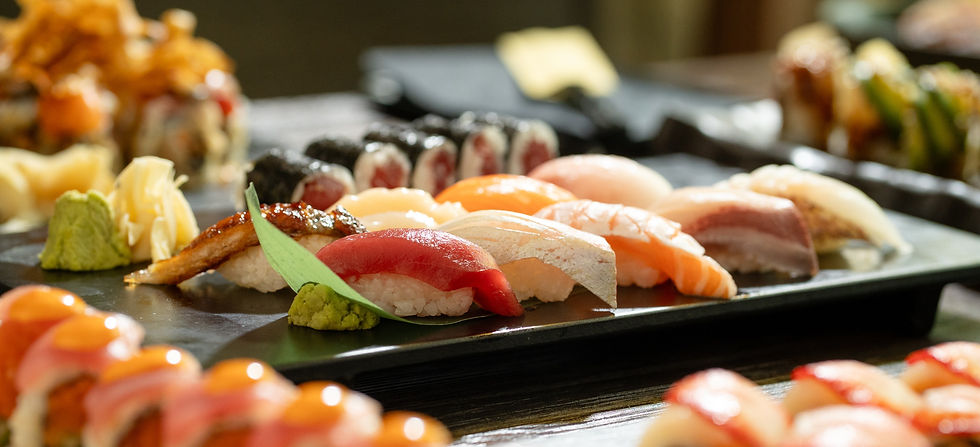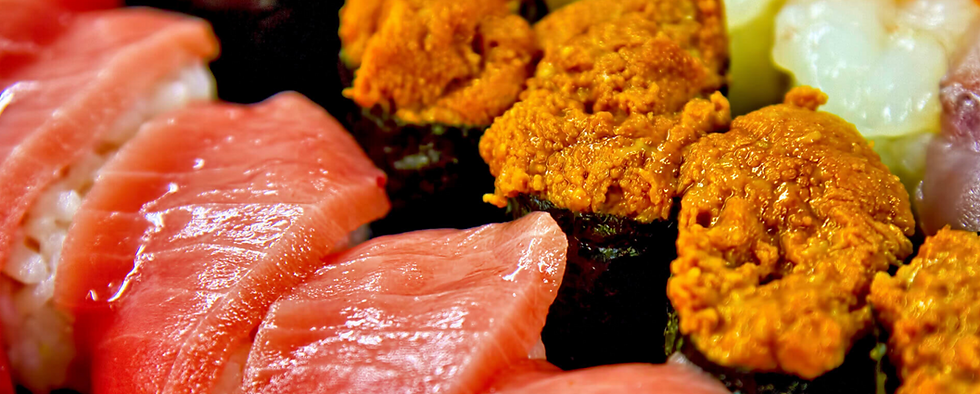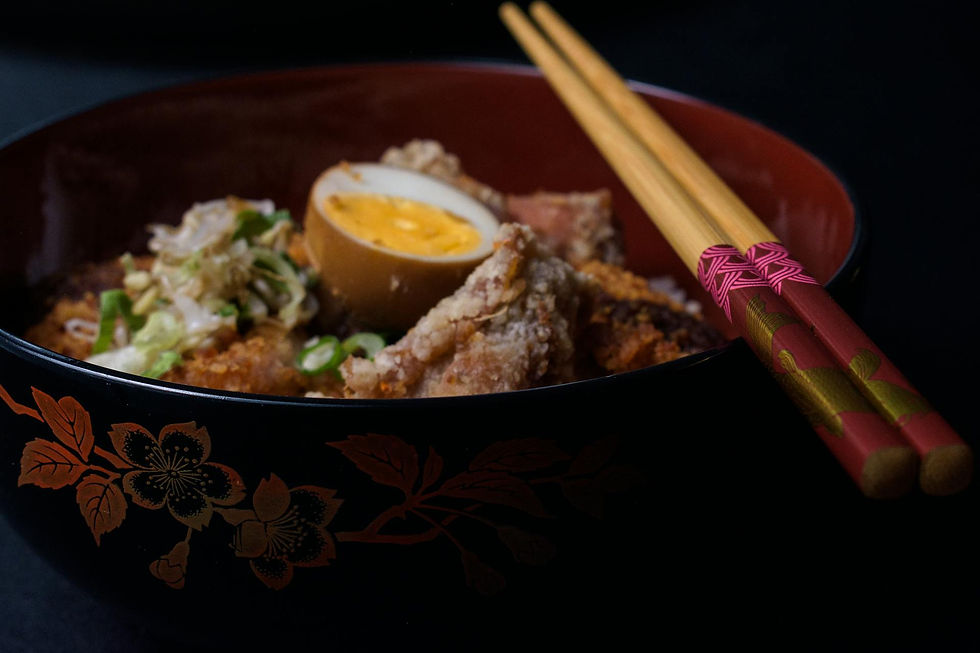Nigiri vs Sashimi
- Takashi Otsuka
- Jul 23
- 10 min read
Introduction to Japanese Cuisine
The Global Appeal of Japanese Food
Japanese cuisine has captivated taste buds around the globe with its harmonious blend of flavors and meticulous presentation. At the heart of this culinary tradition are dishes like nigiri and sashimi, which showcase the beauty of simplicity and the emphasis on fresh ingredients.
However, for those new to Japanese food, the difference between nigiri and sashimi can be quite puzzling.
Why Nigiri and Sashimi Are Often Confused
One reason for the confusion is that both nigiri and sashimi prominently feature raw fish, yet they are distinct in their ingredients and preparation methods.
Nigiri is a type of sushi that pairs a slice of raw fish with a small mound of vinegared rice.
Sashimi, on the other hand, focuses solely on the raw fish or seafood itself, presented without any rice.
These differences may seem subtle, but they have a big impact on texture, taste, and how each dish is traditionally served.
What You’ll Learn in This Guide
In this blog post, we aim to demystify these two popular dishes, providing you with a comprehensive understanding of:
Their key characteristics and how they differ
Traditional preparation techniques
The best ways to enjoy each dish
Tips for identifying high-quality sushi
Insights into Wagaya's unique approach to serving nigiri and sashimi
Whether you’re a food enthusiast, a first-time sushi eater, or simply curious about Japanese cuisine, this guide will enhance your dining experience and help you make informed choices the next time you explore a sushi menu.
Why This Matters
As you read on, you'll gain a deeper appreciation for the craftsmanship involved in creating nigiri and sashimi. We’ll walk you through the key ingredients, traditional methods, and the subtle yet significant differences in flavor, texture, and presentation.
You’ll also find tailored recommendations based on your personal taste preferences, plus a few cultural etiquette tips to elevate your dining experience.
A Flavorful Journey Ahead
Prepare to embark on a flavorful journey that not only clarifies the distinction between nigiri and sashimi but also enriches your appreciation for the artistry behind these beloved Japanese dishes.

What is Nigiri?
A Classic Sushi Staple with Deep Roots
Nigiri is a staple in the world of sushi, tracing its roots back to Japan in the early 19th century. The word “nigiri” literally translates to “two fingers”, referring to the size and shape of the sushi and the way it's traditionally molded by hand.
At its core, nigiri consists of a small, oblong mound of vinegared sushi rice, topped with a slice of raw fish and a dab of wasabi. It’s often served with a touch of soy sauce or occasionally wrapped with a thin strip of nori (seaweed) to hold it all together.
The Beauty of Simplicity
The magic of nigiri lies in its simplicity. The sushi rice, known as shari, is seasoned with a precise mix of rice vinegar, sugar, and salt — giving it a subtle tang that balances the fresh flavor of the fish.
Each piece is handcrafted with care. Sushi chefs apply just the right amount of pressure to shape the rice without compacting it too tightly, preserving its soft, airy texture.
Common Types of Nigiri
Nigiri comes in many varieties, offering different textures and flavor profiles. Here are some of the most popular types:
Type of Nigiri | Japanese Name | Characteristics |
Salmon | Sake | Rich, buttery texture with a mild flavor |
Tuna | Maguro | Deep red color, meaty texture, clean and slightly sweet taste |
Shrimp (cooked) | Ebi | Tender and sweet, perfect for those who prefer non-raw options |
Yellowtail | Hamachi | Firm texture with a slightly oily, rich flavor |
Each type brings something different to the table, making nigiri a great entry point for newcomers and a beloved choice for sushi enthusiasts.
Serving and Etiquette
Nigiri is often served with pickled ginger (gari) on the side, which acts as a palate cleanser between bites. This allows you to fully experience and appreciate the distinct taste of each piece.
If you're dining in a traditional Japanese setting, it's considered polite to eat nigiri in one bite and to dip the fish side (not the rice side) lightly into soy sauce. Too much soy sauce can overwhelm the delicate flavors — and make the rice fall apart.
Why Nigiri is a Must-Try
Whether you're a seasoned sushi lover or just starting your journey into Japanese cuisine, nigiri offers an approachable and authentic way to experience the artistry of sushi-making. Its minimalism, balance of flavors, and handcrafted preparation reflect the essence of Japanese culinary tradition.
Frequently Asked Questions About Nigiri
What does “nigiri” mean in Japanese?
The word nigiri means “two fingers” in Japanese, referring to the size and shape of the sushi and how it's traditionally formed by hand.
Is nigiri considered sushi?
Yes, nigiri is a type of sushi. It includes vinegared rice topped with a slice of raw or cooked seafood, which makes it fall under the broader sushi category.
Can you eat nigiri with your hands?
Absolutely! In fact, eating nigiri with your hands is traditional and often encouraged, especially in casual or authentic Japanese dining settings.
Does nigiri always have raw fish?
Not always. While many popular nigiri types feature raw fish, options like ebi (shrimp) or tamago (sweet egg) are fully cooked and great for beginners.
What’s the best way to dip nigiri in soy sauce?
Dip the fish side (not the rice) lightly into soy sauce to avoid overpowering the flavor and to keep the rice from falling apart.

What is Sashimi?
Pure, Minimalist Japanese Cuisine
Sashimi is a celebrated dish in Japanese cuisine that focuses on the pure, unadulterated flavors of high-quality seafood. Unlike nigiri, sashimi consists solely of thinly sliced raw fish or seafood, served without any accompanying rice. This minimalist approach highlights the natural taste, texture, and freshness of the ingredients — making it a favorite among purists and seafood aficionados.
The Meaning Behind the Name
The term “sashimi” translates to “pierced body,” a reference to the precise knife work required to prepare the dish. Each slice of fish is cut with meticulous attention to texture and presentation, often by highly trained chefs.
Sashimi is typically served with:
A side of soy sauce for dipping
A small amount of wasabi for an optional kick
Garnishes like shredded daikon radish or shiso leaves for freshness and contrast
Popular Types of Sashimi
Here are a few standout types of sashimi you’ll often find on a Japanese menu:
Type of Sashimi | Japanese Name | Flavor Profile & Texture |
Fatty Tuna | Toro | Rich, buttery, melts in your mouth |
Octopus | Tako | Mild flavor, chewy texture |
Scallop | Hotate | Sweet, tender, and delicate |
These selections showcase the wide range of textures and tastes found in sashimi — from bold and fatty to light and refreshing.
The Importance of Freshness and Skill
One of the most critical aspects of sashimi is the freshness and quality of the seafood. Only the best cuts are used, often sourced from trusted suppliers and handled with extreme care. The chef’s expertise in knife skills, slicing technique, and visual presentation all contribute to a truly elevated dining experience.
Sashimi is often arranged artfully on the plate — making the dish not only a culinary highlight but also a visual one. The vibrant colors and clean, precise cuts reflect the craftsmanship behind every serving.
Why Sashimi Stands Out
Whether you're a longtime sushi lover or just starting your journey with Japanese cuisine, sashimi offers a refined and authentic taste of the ocean. With no rice or heavy seasoning to distract from the flavor, it’s the perfect way to savor the true essence of fresh seafood.
Frequently Asked Questions About Sashimi
What does “sashimi” mean in Japanese?
“Sashimi” means “pierced body,” referencing the slicing technique used to prepare the seafood.
Is sashimi always raw?
Yes, sashimi traditionally consists of raw seafood, though some variations like tako (octopus) may be lightly cooked for texture.
What’s the difference between sashimi and nigiri?
Sashimi is thinly sliced raw fish served on its own. Nigiri includes a slice of fish on top of vinegared rice.
Can I eat sashimi with chopsticks or hands?
Sashimi is typically eaten with chopsticks, but there's no strict rule — comfort and respect are what matter most.
Is sashimi safe to eat?
Yes, when sourced and handled properly by trained professionals, sashimi is very safe. Look for restaurants that prioritize freshness and quality.

Nigiri vs Sashimi: The Main Differences
Why It’s Easy to Confuse Nigiri and Sashimi
At first glance, nigiri and sashimi may seem similar — both are beautifully presented, often feature raw fish, and are central to Japanese cuisine. But when you take a closer look, these dishes have distinct characteristics that set them apart.
Understanding these differences will not only improve your sushi knowledge, but also help you make more informed choices when ordering.
Ingredients at the Core
The most noticeable difference lies in the ingredients:
Nigiri features a hand-shaped mound of vinegared rice topped with a slice of raw or cooked seafood. Wasabi is often added between the rice and fish for a gentle kick.
Sashimi is served without rice, focusing purely on thin slices of raw fish or seafood, often accompanied by simple garnishes.
Comparison Table – Nigiri vs Sashimi
Feature | Nigiri | Sashimi |
Base | Vinegared rice + raw/cooked fish | Raw fish or seafood only (no rice) |
Presentation | Typically served in pairs | Often artfully arranged in sliced sets |
Preparation | Hand-formed rice, topped with sliced fish | Fish sliced with precision and plated |
Texture | Balanced bite: soft rice + smooth fish | Pure texture of the seafood itself |
Nutrition | Contains carbs from rice | Lower carb, high in protein and omega-3s |
Popular With | Sushi beginners & regulars | Seafood purists & low-carb eaters |
Flavor, Texture, and Presentation
Nigiri provides a balanced bite — the mild tanginess of the rice pairs with the smooth, delicate flavor of the fish. The wasabi adds depth without overpowering the other elements.
Sashimi, by contrast, is all about the seafood. From the buttery richness of toro (fatty tuna) to the firmer texture of tako (octopus), sashimi highlights the pure mouthfeel of each type of fish.
When it comes to presentation, nigiri emphasizes minimalist harmony — usually served in pairs. Sashimi is often plated more artistically, with vibrant colors and elegant slicing techniques on display.
Nutrition and Dietary Considerations
Nigiri includes carbohydrates from the rice, making it slightly more filling. It’s great for those looking for a complete sushi experience.
Sashimi, on the other hand, is a lighter, protein-focused option. It’s ideal for low-carb diets, keto-friendly eating, or anyone seeking the cleanest taste of the sea.
Which Should You Choose?
The choice between nigiri and sashimi ultimately comes down to your preferences:
Want something light and protein-rich? Go for sashimi.
Prefer a more balanced bite with rice? Nigiri is your match.
New to sushi? Starting with nigiri is often less intimidating.
Frequently Asked Questions About Nigiri vs Sashimi
What’s the main difference between nigiri and sashimi?
Nigiri includes rice topped with seafood; sashimi is just sliced raw fish or seafood, served without rice.
Is sashimi healthier than nigiri?
Sashimi is typically lower in calories and carbs because it doesn't include rice, making it a lighter choice for some diets.
Can I eat both nigiri and sashimi in one meal?
Absolutely! Many sushi meals include both for variety. It’s a great way to experience the full range of Japanese seafood preparation.
Does sashimi require more skill to prepare?
Both dishes require skill, but sashimi demands especially precise knife work to maintain texture, shape, and presentation.
Is nigiri or sashimi better for beginners?
Nigiri is often more approachable for first-timers due to its familiar rice base. Sashimi may appeal more to those who enjoy the pure taste of seafood.

Which Should You Try First?
Choosing Between Nigiri and Sashimi as a Beginner
When deciding whether to start with nigiri or sashimi, it helps to consider your comfort level with raw seafood and your personal taste preferences.
Nigiri is often the more approachable choice for those new to Japanese cuisine. It combines familiar rice with a slice of fresh fish or seafood, offering a balanced, mild flavor. The vinegared rice (shari) provides a slightly tangy base that makes the raw fish feel less intense for beginners.
If you’re not quite ready for raw fish, you can ease into the experience by trying cooked options like ebi (shrimp) nigiri.
When to Choose Sashimi
If you’re curious about the pure, clean taste of high-quality seafood, sashimi might be the better choice. Without rice or added elements, sashimi lets the flavor and texture of the fish take center stage. It’s ideal for those who enjoy subtlety and want to experience the freshest, most authentic version of each ingredient.
Each slice is carefully cut to bring out the best characteristics of the fish — and often plated with elegant garnishes like daikon radish or shiso leaves.
A Quick Comparison – Which Is Best for You?
Preference | Try This First |
New to raw fish | Nigiri |
Prefer milder flavors | Nigiri |
Following a low-carb diet | Sashimi |
Want to taste pure seafood | Sashimi |
Curious but hesitant | Cooked nigiri |
Dining Etiquette Tips
Knowing how to enjoy these dishes respectfully enhances the experience:
For nigiri, lightly dip the fish side into soy sauce — not the rice — to preserve the flavor and structure.
A small amount of wasabi can be added to your soy sauce, or placed between the rice and fish if not already added.
For sashimi, you can put a small dab of wasabi directly on the fish before dipping it into soy sauce. Less is more.
Savoring the Experience
Eating nigiri or sashimi isn’t just about the taste — it’s about the entire experience. Watching the sushi chef at work, appreciating the clean presentation, and savoring each bite slowly adds meaning to the meal.
Whether you choose nigiri or sashimi, take your time. Enjoy the textures, the temperature, and the story behind each piece. That’s the essence of Japanese dining: intentional, mindful enjoyment.
Frequently Asked Questions About Trying Nigiri or Sashimi First
Is nigiri easier for beginners than sashimi?
Yes, many beginners start with nigiri because the rice base softens the intensity of the raw fish and creates a more balanced bite.
Can I try cooked nigiri if I’m not ready for raw fish?
Absolutely! Cooked options like shrimp (ebi), egg (tamago), or even seared salmon (aburi sake) nigiri are excellent starter choices.
Does sashimi taste stronger than nigiri?
Not necessarily stronger, but it is more concentrated. Since sashimi has no rice or sauces, you taste only the fish, which can feel more intense or “pure.”
What if I don’t like wasabi?
No problem — you can skip it entirely or ask the chef to leave it out. Wasabi is traditional, but not required for enjoying nigiri or sashimi.
Should I use chopsticks or hands?
For sashimi, use chopsticks. For nigiri, both chopsticks and clean hands are acceptable — and using your hands is actually traditional.




Comments